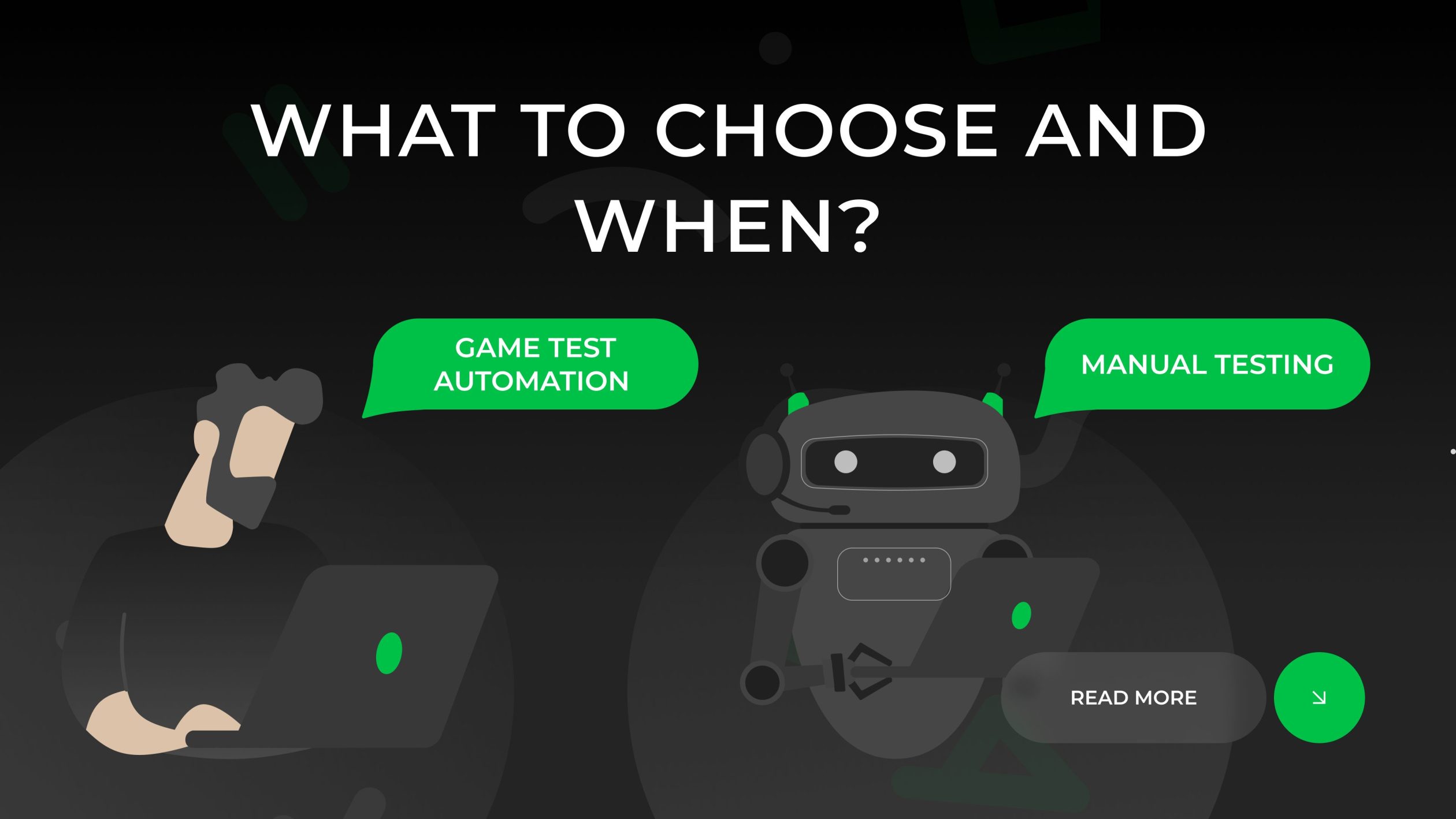In the ever-evolving world of game development, ensuring that a game is free of bugs and performs optimally is paramount. As developers, the choice between game test automation and manual testing often presents a dilemma. Both methods have their unique advantages and limitations, and understanding when to leverage each can significantly impact the efficiency of your quality assurance (QA) process.
Understanding Game Test Automation
Game test automation involves using scripts and tools to perform repetitive testing tasks without human intervention. This approach is particularly effective for large-scale projects with extensive codebases and frequent updates. Automation can handle a high volume of tests quickly, ensuring that new builds are thoroughly vetted for regressions or new bugs.
Pros and Cons of Test Automation
| Pros | Cons |
| Speed: Executes tests rapidly, ideal for fast iterations and frequent updates. | Initial Investment: High setup costs in terms of time and resources, requiring skilled developers for scripting. |
| Consistency: Provides uniform results, eliminating the risk of human error. | Maintenance: Automated scripts need regular updates to stay relevant as the game evolves. |
| Scalability: Easily scales to handle large, complex projects with extensive codebases. | Limited Coverage: Struggles with testing areas that require human judgment, such as UX and gameplay feel. |
| Reusability: Once created, test scripts can be reused across multiple testing cycles, saving time. | False Positives/Negatives: Can sometimes produce misleading results, requiring additional validation. |
| Integration with CI/CD: Integrates seamlessly into CI/CD pipelines, enabling continuous testing throughout development. | Lack of Human Insight: Cannot assess subjective aspects of the game, such as user experience or visual quality. |
| Platform/Configuration Testing: Efficiently tests across multiple platforms and configurations. | Upfront Complexity: The initial creation and setup of automated tests can be complex and time-consuming. |
Insights on Test Automation
- Best Practices: For successful implementation of test automation, it’s crucial to define clear testing goals, prioritize tests that benefit most from automation (like regression tests), and regularly update test scripts to reflect changes in the game.
- Tool Selection: Choosing the right tools is vital. There are many automation tools available, each with different strengths. Consider factors like ease of integration with your development environment, the learning curve for your team, and the ability to handle multiple platforms.
- Data-Driven Testing: Automation shines in scenarios where large datasets or multiple configurations need to be tested. By automating these tests, you can ensure comprehensive coverage without overwhelming manual testers.
- Performance Testing: Automation is particularly effective for performance testing, where the system’s response under load needs to be measured consistently and reliably. This is critical for multiplayer games or games expected to handle high traffic.
Manual Testing
Manual Testing involves human testers playing through the game and identifying bugs, issues, or areas for improvement. This method is invaluable for understanding the game from a player’s perspective and evaluating subjective aspects like user experience.
Pros and Cons of Manual Testing
| Pros | Cons |
| Human Insight: Provides valuable feedback on user experience, gameplay feel, and design elements that automation cannot assess. | Time-Consuming: Slower than automated testing, especially for repetitive tasks or large-scale testing. |
| Adaptability: Testers can quickly adapt to new or unexpected issues, exploring them in real-time. | Inconsistency: Susceptible to human error and variability, leading to potential inconsistencies in test results. |
| Exploratory Testing: Ideal for discovering edge cases and subtle bugs through creative exploration. | Scalability: Difficult to scale, especially for large projects with extensive testing needs. |
| Creative Feedback: Testers can provide subjective feedback on the game’s appeal, helping refine gameplay and design choices. | Cost: Can be costly in terms of labor, especially for projects requiring extensive manual testing across multiple platforms. |
| Low Initial Investment: Requires minimal setup, relying on the testers’ skills and experience. | Limited Coverage: May not cover every possible scenario, particularly in complex systems or configurations. |
| Early Development Flexibility: Invaluable for iterating on core mechanics and design in the early stages of development. | Difficult Integration with CI/CD: Manual tests are harder to integrate into automated workflows, making continuous testing challenging. |
Insights on Manual Testing
- Exploratory and Ad-Hoc Testing: One of the most significant advantages of manual testing is its flexibility. Testers can think like players, exploring the game in unpredictable ways and discovering issues that scripted tests might miss. This is especially useful in the creative phase of game development.
- Subjective Assessments: Unlike automation, manual testing can gauge subjective elements like game enjoyment, emotional impact, and visual appeal. Testers can provide detailed feedback on how the game feels, which is essential for refining gameplay and ensuring player satisfaction.
- Communication and Collaboration: Manual testers often work closely with developers, providing immediate feedback and suggestions. This real-time collaboration can lead to faster identification and resolution of issues, contributing to a smoother development process.
- Usability Testing: Manual testing is crucial for assessing how intuitive the game is for players. Testers can evaluate the user interface (UI) and user experience (UX), identifying areas where players might struggle or become frustrated, which can be refined before release.
Choosing the Right Method
When deciding between test automation and manual testing, consider the specific needs of your project. Test Automation is ideal for large-scale projects, repetitive tasks, and scenarios where speed and consistency are critical. Manual Testing, on the other hand, is essential for areas where human insight, creativity, and adaptability are required.
Which Testing Method to Choose Based on Game Type, Size, and Goals
| Game Type/Size/Goal | Recommended Testing Method | Rationale |
| AAA Games (Large-scale, High Budget) | Hybrid – Combine automation for regression and scalability, with manual testing for UX and gameplay. | Large games require extensive testing; automation covers repetitive tasks, while manual testing ensures quality and player experience. |
| Indie Games (Small-scale, Low Budget) | Manual Testing – Focus on manual testing with limited automation for critical paths. | Limited resources make extensive automation impractical; manual testing provides necessary feedback on gameplay and UX. |
| Mobile Games | Automation for Regression, Manual for UX – Automate repetitive tests and manual testing for touch controls and UX. | Mobile games require frequent updates; automation handles regression, while manual testing ensures touch and UX quality. |
| Games with Frequent Updates (Live Service) | Automation – Prioritize automation for regression, performance, and cross-platform consistency. | Continuous updates demand quick turnaround; automation ensures stability across updates. |
| Early Development Stage (Prototyping) | Manual Testing – Focus on manual, exploratory testing to refine core mechanics and design. | Early development benefits from human feedback to iterate on gameplay and design concepts. |
| Late Development Stage (Pre-launch) | Hybrid – Use automation to catch regressions and manual testing for final UX polish and gameplay balance. | Ensures the game is stable and enjoyable before release by combining the strengths of both methods. |
| VR/AR Games | Manual Testing – Essential for assessing immersion, UX, and motion sickness, with limited automation for performance testing. | VR/AR experiences require human judgment for immersion and comfort, areas where automation falls short. |
| Multiplayer/Online Games | Automation for Load Testing, Manual for User Experience – Automate stress and load testing, manual testing for multiplayer dynamics. | Multiplayer games need to handle large numbers of players; automation ensures performance, while manual testing assesses gameplay interaction. |
| Games with Complex AI or Procedural Generation | Hybrid – Automate testing of AI behaviors and procedures, with manual testing for edge cases and player experience. | Automation efficiently tests procedural content, while manual testing ensures the content feels right to players. |
Conclusion
Choosing between game test automation and manual testing depends on the specific needs of your game, the stage of development, and your goals. A hybrid approach often offers the best balance, leveraging automation for efficiency and consistency while relying on manual testing for creativity, adaptability, and user experience assessment. By tailoring your testing strategy to the type and scale of your project, you can ensure a high-quality game that meets player expectations.













